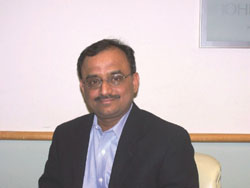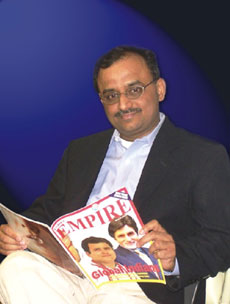| |
 |
Capitalist’s Tool maker
His nifty products give senior managers a god’s-eye-view of their company, and
though he is a niche player, US-based Chandra Sekar is making the big guys of
enterprise software break into a sweat
|
|
By Arnelle
Hartenstein in New Jersey
|
 |
|
“The last three years have placed a unique demand on
CEOs, CFOs and senior executives. They are tested for their magic and acrobatic
circus acts, not for their conventional management acumen anymore. As a senior
executive, it is your ability to jump through the hoops and juggle contradicting
goals that matters. You have to cut spending while firing up innovation,
outsource while nurturing core competency, ensure compliance while ensuring
freedom of decision making, accelerate time-to-market while not compromising on
quality of delivery and operational risk.” |
These are the words of Chandra Sekar, the founder of OpenMetrik, a New
Jersey-based enterprise software product company specialising in a new class of
enterprise software called real-time management control systems.
Chandra speaks with a sense of humour, yet driving and staying focussed when it
comes to criticising the current management governance methods and tools.
OpenMetrik, the company as well as the product, is driven by a single
“cut-to-the-chase” motto of eliminating disjointed pieces of software and
disparate processes. The problem of management data collection is very simple.
Enterprise software vendors complicate the issue, solve only parts of the
puzzle, and leave the senior executives high and dry when it comes to
interoperability. Senior executives are presented with tons and tons of reports
and graphs, but the decision support is like a blind man touching an elephant.
Started in the year 2000 as the first real-time management control system, the
company's first product was “eCIO”, dedicated to automating all IT core
processes. “eCIO” was sold to only a few but visionary and futuristic
organisations. eCIO came with its own drawbacks. It demanded an openness and
level of accountability, which scared mid-level managers. They thought of “eCIO”
as a policing system, not one that really saved them time dollars, as well as
aggravations and frustrations. “It was difficult to find buyers who could bite
the bullet and bring about changes in their organisations — and to establish
fullest visibility and accountability,” Chandra says.
Chandra is not dreaming or preaching about management theories - OpenMetrik's
product suite has been successfully implemented in large-scale global companies.
|
Take a customer success story. John Hill, Global CIO of Praxair
and a customer of OpenMetrik, wrote in the CIO magazine in July 2002: “It offers
a single repository that lets Praxair manage our core processes with a single
tool and helps standardize our core processes. Praxair used to rely on a number
of tools, including Microsoft Project and Artemis. Think of eCIO as an ERP
function. We expect to use this product as our knowledge management tool as
well.” Hill, a graduate of Princeton University and a public speaker in CIO
forums, had just one three-hour meeting with Chandra before he decided to
implement the tool globally.
“If survival is to be called success, then we are a success story,” says Chandra
enthusiastically. “Our single product offers all of the core functionality you
would expect from a strategy mapping system. It incorporates a financial system,
a project management system, and a tactical data collection system, all placed
into one system. Why buy from many vendors and try to integrate them in vain?” |
|

|
In 2002, Chandra decided to pump all the capital he received from a few sales
back into product development. “We knew that spending money in marketing would
not help,” he says. OpenMetrik introduced HyperLens, the second generation of
management control systems. HyperLens is applicable not only to IT, but also for
new product development and R&D projects management, as well as management of
large business processes. HyperLens was implemented in large telecom companies
and financial services industries. HyperLens, as a single system manages about
500 critical projects from all perspectives, with about 300 line managers using
the system on a day-to-day basis. If it saves them two hours a week, the payback
is tens of millions of dollars a year.
OpenMetrik demonstrated that at the Gartner Portfolio Management Summit in San
Francisco in 2003. It was the only company running the actual full version of
the software, while management advisory firms were predicting such an integrated
enterprise to emerge in a few years.
OpenMetrik is now introducing a new product suite that implements a true,
Metrics-driven enterprise. It drastically reduces the cost and complexity to
govern the enterprise. It frees you from reporting chores, management meetings
and excessive email clutter. It allows you to concentrate on your business
instead of getting caught in bureaucratic minutia.
On himself Chandra says, “There is nothing much to talk. My only dream is our
efforts should one day come in the limelight. We are bringing limitless business
value, besides inculcating the discipline of delivery, accountability and senior
management visibility all in one product.”
An instrumentation engineer from Madras, Chandra did his masters in technology
management in the US. He worked in France and Canada, for MNCs like Oracle and
Nortel, before moving to the US in 1992. Living in New Jersey, makes it easy for
him to flit in and out of, which is an added bonus. “I love New York. I loved
the World Trade Center and what it stood for,” he says.
His wife, a homemaker, brings up their two children with Indian values and
virtues, supports his interests and nurtures his dreams. “I am intense in my
dreams and in my planning. I will always walk on even from the saddest moments,
like a phoenix, always rising from the ashes,” he says. There is justifiable
pride in his voice as he makes that statement.
|
|
|
|